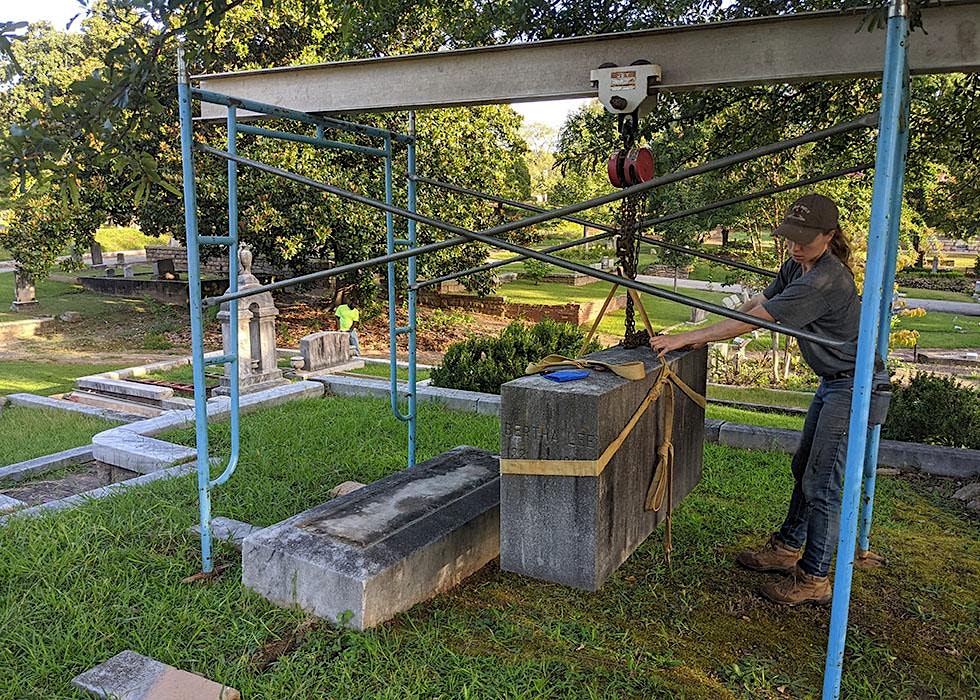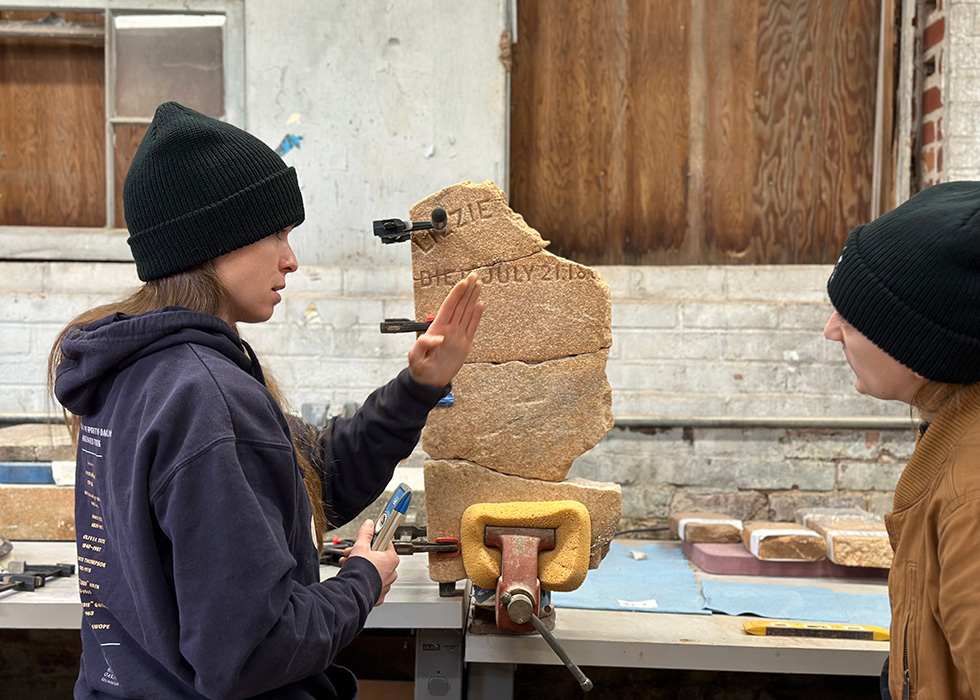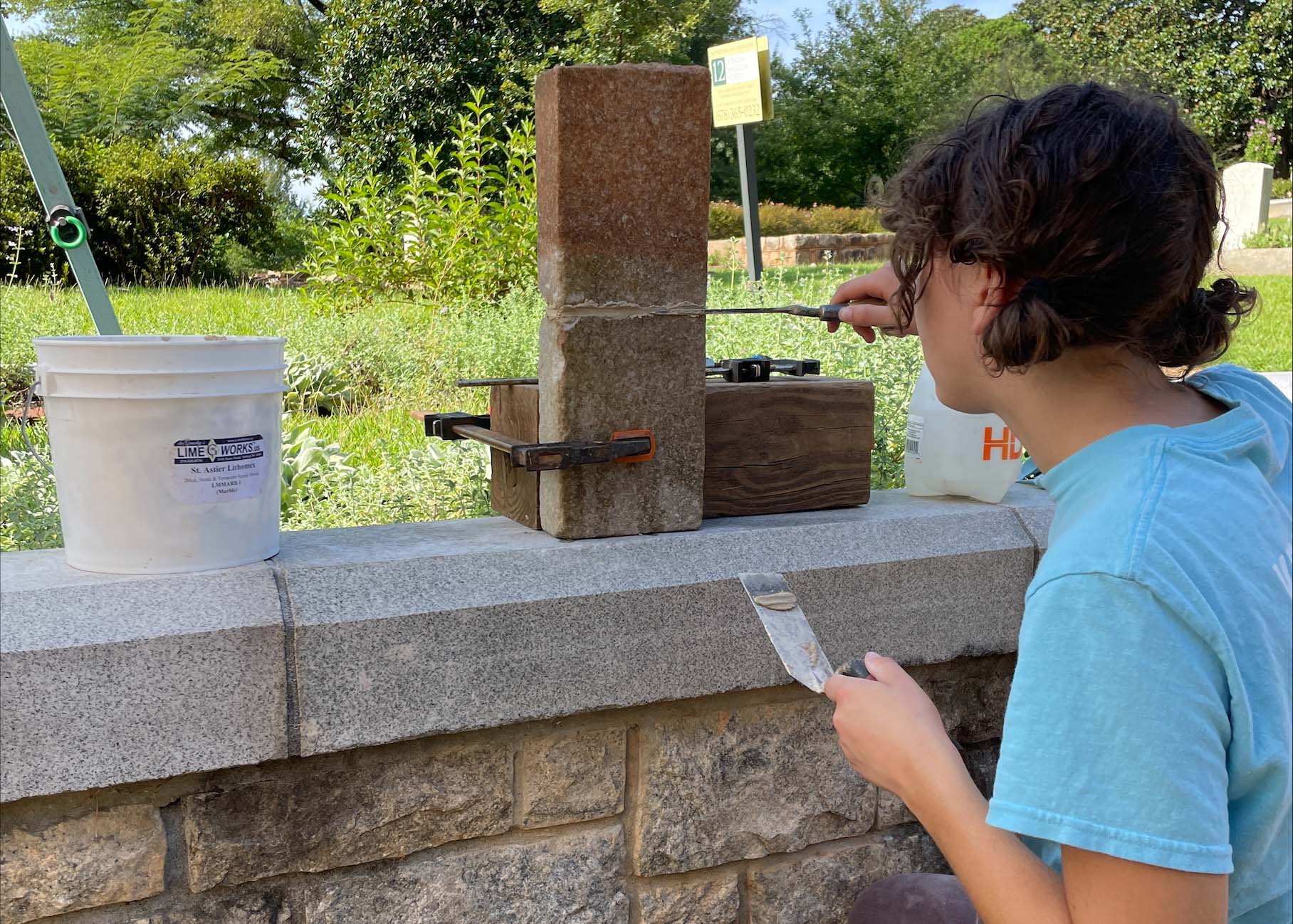
PRO Team Field Notes: Restoration and Preservation for Eliza S. Blake
by DL Henderson
The first phase of the African American Grounds restoration has presented the Preservation, Restoration, and Operations (PRO) Team with many unique challenges and opportunities to hone our conservation skills. When we began working in Block 68, we discovered a brick bedstead bordering a marble monument that was almost entirely overgrown with grass.
Most brick cradling is only one horizontal row deep (called a course) and often not mortared together in any way. Once we began carefully digging, we realized quickly that the bricks were cemented together with a high-portland content mortar and embedded in a thick layer of concrete that covered the entire grave space. Portland is what gives a mortar its rigidity, adhesion, and compressive strength. It is easy for us to tell when we encounter a mix that has a high percentage of portland because it cannot be easily scratched with a nail, and dislodging bricks or stone from it is challenging. The bricks, in this case, were laid three – or in some places – four courses deep so what at first presented itself as an easy project of simply relaying one course of brick turned into a major undertaking.
Because there were several courses and the mortar joints between them were very neatly tooled, the PRO Team determined that the installer had probably intended for more than a small portion of brick to be visible at ground level. Otherwise, they wouldn’t have taken the time to do such neat work. It was decided that the bricks should all be removed and reset at a higher grade. However, although we could remove the top courses, the course embedded in concrete was impossible to chisel out without breaking the bricks. As often happens, the PRO Team had to make a compromise between preservation and restoration.
Preservation is the act of stabilizing and conserving an object with as little intrusion as possible. On the other hand, restoration involves returning an object to the appearance and character it held during a historical “period of significance.” In the case of cemeteries, this means the day that the stone was first laid. At Oakland Cemetery, most of our projects involve a careful balance of both preservation and restoration.
On this particular project, we skewed more towards restoration. In order to ensure that the original top course of bricks was fully exposed above the soil line, we decided to add a course of modern bricks beneath the older ones. This allows the bedstead to appear the way it originally did. The mortar we used has high compressive strength and a similar color to what originally was used to lay them. In the end, we replaced the old gravel that filled the interior with new, fresher-looking 89 stone gravel.
The newly restored brick cradle encloses the grave of Eliza Street Blake. She rests among family members, all of whom predeceased her—mother Amanda Blake (d. 1877), uncle Lucien Heard* (d. 1881), grandmother Adrian Heard (d. 1884), and three-year-old Cornelius F. Blake (d. 1886) who lies in an unmarked grave. A 1928 advertisement in the Atlanta Constitution offered the sale of three graves spaces in the “colored section” of Oakland Cemetery. Interested parties were instructed to apply at 264 Ellis Street, Eliza Blake’s residence. Today, three unused spaces still remain on her family lot.
In late March 1936, Eliza Blake took a fall down the steps at her home and fractured her right upper arm. Aged 83, she already suffered from a heart problem, and she was impaired by dementia, or senility, as it was then called. During the week following her fall, Blake developed pneumonia, which further complicated her recovery. She died at William A. Harris Memorial Hospital on March 31, 1936. Her brief obituary noted that she was “a beloved matron” in her community. According to her death certificate, she never married, though she was referred to respectfully by the honorific “Mrs.” in both her obituary and in Oakland’s burial records. Her funeral was held at Big Bethel African Methodist Episcopal Church, where she was a member of the Independent Daughters of Bethel. She worked her entire life as a domestic servant, yet Mrs. Blake managed to leave a sizable legacy to her church—a bequest of $1,500.
*primarily documented as Lucius Heard




